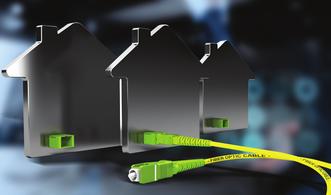ABSTRACT
As telecom operators across the world ramp up FTTx deployment, a cost-effective solution that can boost deployment speed is the need of the hour. This paper describes a pre-connectorized solution to deploy fibre in Multi-Dwelling Unit (MDU) and its advantages over the field – connectorized solutions in terms of cost, time, installation skill and materials.
KEYWORDS
FTTx, Pre-connectorized cable, Fast deployment
Introduction
Over the past four decades, the optical fibre has become one of the leading transmission mediums for communication systems. Optical fibre cable has been found to be an ideal solution for various application starting from the medical through to the submarine, terrestrial, sensor and data storage industries. Submarine optical fibre cables are connecting even the remotest parts of the world to the Internet. Increasingly, fibre is reaching deeper into home, businesses, factories and administrations enjoying the benefits of the superfast broadband. By 2020, over half the world is expected to have access to FTTx, which will make up 80% of broadband connections. Deployment of FTTH for greater capacity per subscriber, will need customized solutions to adapt to the varied landscape of cities. More components, dierent types of cables, optimal network design and new installation methods will be needed for mass and fast deployment of FTTH. In this paper we focus on a solution for easy and fast deployment of fibre in MDU using installer’s existing skills.
Challenges faced during FTTH deployment
- The most common challenges faced during FTTH deployment in MDU (Multi-Dwelling Units) are
- Requirement of skilled man power for field termination (i.e. fibre splicing)
- Requirement of skilled man-power to follow standard practices during FTTH roll-out
- Provision for safe and secure storage of excess cable (cable slack)
- Availability of expensive fiber splicing machine for large scale roll-outs
- High number of materials/ accessories are need to be handled in the field
- Network reliability – excess fibre bending leading to unexpected increased bend losses,
- High splice loss in dusty building shaft environments
Sterlite Tech’s FTTH solution for MDU: Customization and Engineering
Deploying FTTH means reaching those final few hundred meters to the private detached home or building MDU complex from the nearest node where fibre is present. Sterlite has designed a passive ODN (Optical Distribution Network) solution which complies to class B+ optics i.e. 28dB power budget consideration.
Sterlite Tech’s smarter FTTH Plug and Play Passive Solution enables fastest and reliable connectivity, which helps operators to complete Home Pass readiness in the shortest possible deployment time in high-rise and medium rise building scenarios; that too at the lowest total cost of ownership. Key attributes of the solution includes Compact, Modular and, Re-configurable Passive Enclosures, namely Main Distribution Box (MDB), Basement Distribution Box (BDB), and Fibre Access Termination-8 (FAT-8).
It supports dierent splitter ratio combinations. The solution can also be mixed and matched to enable both centralized and two stage splitting architecture as per varied deployment requirements of the telecom operators and infrastructure players.
All passive enclosures have very stringent Ingress Protection (IP) features (minimum of IP-65) that are compatible with both pole and wallmount installations, giving the additional flexibility during installation. These enclosures also include splice holders to splice pigtails to the drop cables as and when required during its operation lifetime.
A rodent resistant spiral metal armour compact cable for stringent indoor (vertical and horizontal shafts) and outside deployment conditions has been used in this solution. The cable is made with Sterlite Tech’s bend insensitive ITU-T G.657 compliant BOW LITE™ series optical fibres. The key features of the solution and how it will overcome the challenges are explained below.


